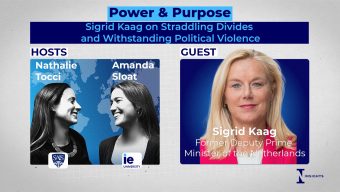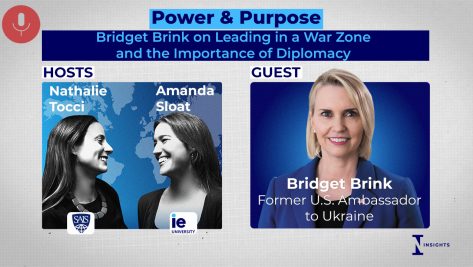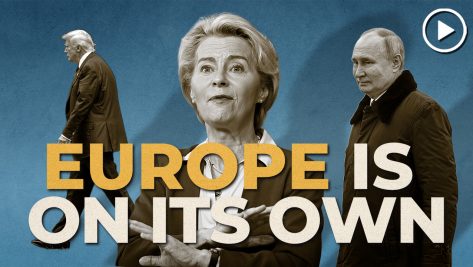Recent developments in the Transatlantic agenda have made dual-use technologies – those with both civilian and military applications – a top priority as never before. For example, Russia’s full-scale invasion of Ukraine in 2022 pushed both the European Union and the United States closer to deploying sanctions against the Kremlin. The US also imposed export controls on China’s access to semiconductors and supercomputing capabilities, bringing along the Netherlands and Japan in the process. The unilateral nature of that decision, however, disquieted many EU leaders. What is clear from these events, though, is that they highlight a reality in which the intersection of trade and technology is a critical national security issue in international relations.
Dual-use technologies are fundamentally strategic for international markets and a wide array of industries and include advanced semiconductors, artificial intelligence, biotechnologies, and quantum technologies. For example, semiconductors are used in unmanned aerial vehicles (UAV), global positioning systems, radars, and missile guiding systems, among other military applications. With AI, governments can enhance national security decision-making by processing and collating large amounts of data and identifying patterns and trends that the human mind cannot. Quantum computers and technologies, on the other hand, can tackle complex mathematical problems much quicker than conventional computing, raising concerns about whether existing encryption methods are safe enough to safeguard classified government data and information.
The United States outlines in its National Security Strategy the need to work with allies and partners to harness and scale “the foundational technologies of the 21st century.” The Biden administration mentions semiconductors, advanced computing, quantum technologies, and biotechnology, among others. In June 2023, the EU released its Economic Security Strategy, with a relevant update in January 2024. In there, the EU also considers advanced semiconductors, artificial intelligence, and biological and quantum technologies as crucial dual-use technologies for the EU and its member states. Both powers also converge in the need to “de-risk” from China’s perilous economic dependencies in such domains.
However, the often defused and inconclusive meaning of “dual-use” does not make it easy to govern these technologies. For example, if one lights a cigarette, a civilian object, and uses it to hurt someone, does that make the cigarette a dual-use good? Not really. The definition of what makes a technology dual-use or not is not based on essentialist arguments but on the context surrounding its military applications. The dual-use potential for technology is guided by science, innovation, and strategic investments, among other conditions, which makes the dual-use aspect of technologies fluid and dynamic, evolving and changing over time due to scientific revolutions in the military sector.
Competition driven by dual-use technologies is slowly diminishing other traditional multilateral instruments.
In “The Logic of Strategic Assets: From Oil to AI,” Jeffrey Ding and Allan Dafoe, both at the University of Oxford, provide a useful framework to understand why certain goods are considered strategic for nation-states. First, these dual-use technologies often generate high market barriers and economies of scale for the actor that has “discovered” the good. A key example could be the advanced semiconductors from Taiwan Semiconductor Manufacturing Company. Once Taiwan developed its fabs and its comparative advantage, there was no way for another actor to compete with their market share.
Second, as Ding and Dafoe point out, the actor that dominates the strategic asset can leverage its scarcity to its advantage by cutting its supply and obtaining concessions in exchange. It is not the first time a similar case has happened. In October 1973, the Organization of Arab Petroleum Exporting Countries deployed a total oil embargo against the countries that had supported Israel during the Yom Kippur War, causing concerning stagflation. A current example would be the set of export controls from the United States, the Netherlands, and Japan against China’s access to semiconductors, as each country bears a strategic share of the semiconductor supply chain and uses it to its advantage.
Thirdly, these technologies can have a transferable capacity from the civilian to the military sector, which is what makes them dual-use. On this, it is timely to recall Robert Jervis’ security dilemma, in which country A increasing its security leads to country B fearing for its own, thereby leading to an arms race and escalation. The dilemma is difficult to avoid when two conditions are met: 1) it is difficult to distinguish between offensive and defensive weapons, and 2) the offensive has the advantage. Under these two precepts, the security dilemma is most likely to happen. Revisiting the realist theory behind this concept may help us to understand why dual-use technologies increase the security dilemma. Dual-use technologies such as semiconductors diffuse even further the distinction between offensive and defensive; however, the diffusion between civilian and military use adds another layer of uncertainty and mistrust in the picture.
Managing uncertainty and mistrust is one of the main reasons why states have traditionally governed these dual-use technologies under multilateral spaces like the Wassenaar Arrangement, the multilateral body that regulates dual-use and defense goods. Through Wassenaar, countries have agreed on multilateral lists and export controls to limit the proliferation of these dual-use technologies. If country A and country B do not agree on limiting these dual-use technologies, they will continue to proliferate and pose insecurity. In this sense, trust-building mechanisms to disclose sensitive information between countries have been fundamental to understanding which technologies can lead to military applications and limit their spread.
However, as dual-use technologies contribute to this aspect of uncertainty and mistrust, the Wassenaar Arrangement is increasingly being deemed obsolete. Since 2022, Moscow has continuously boycotted progress at Wassenaar. Additionally, the White House’s export controls against China have surpassed the thresholds agreed upon at Wassenaar. The United States has also pushed the European Union to adopt a stronger stance on China due to its funding of Russia’s non-lethal equipment parts with many dual-use technologies that are part of the Wassenaar arrangement.
The aforementioned examples are also happening at a time when competition driven by dual-use technologies is slowly diminishing other traditional multilateral instruments like the World Trade Organization or the G20. As these multilateral institutions are unable to tackle national security concerns, they are being replaced by more restrictive and mini-lateral arrangements led by the United States. Examples of this mini-lateral approach would be the G7 or the U.S.-EU TTC. Under this new setting of more restricted international cooperation, developments in semiconductors, artificial intelligence, and quantum technologies, among other dual-use goods, are pushing every political bloc to develop strategies for securing these dual-use technologies at the intersection of trade, technology, and security.
In a world where dual-use technologies seem to securitize supply chains and science and innovation, pursuing multilateral initiatives and spaces seems to be increasingly difficult. The securitization of these technologies and their supply chains is reshaping the world with a different power focus and perceptions of trade and technology. A critical question for policymakers would be whether dual-use technologies have been influencing a shift in the post-Cold War international order, or whether they are just a symptom of a bigger trend in our global system amid a return to “geopolitics.”
© IE Insights.











